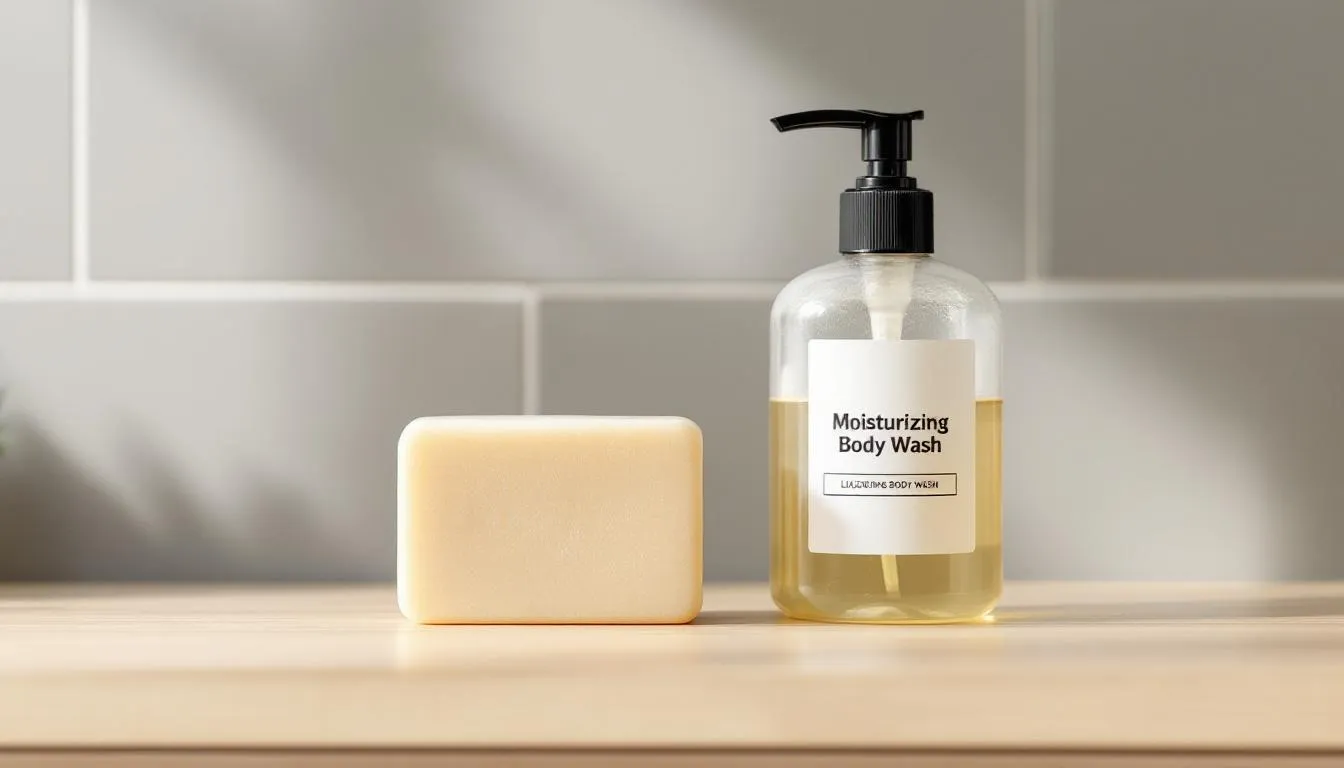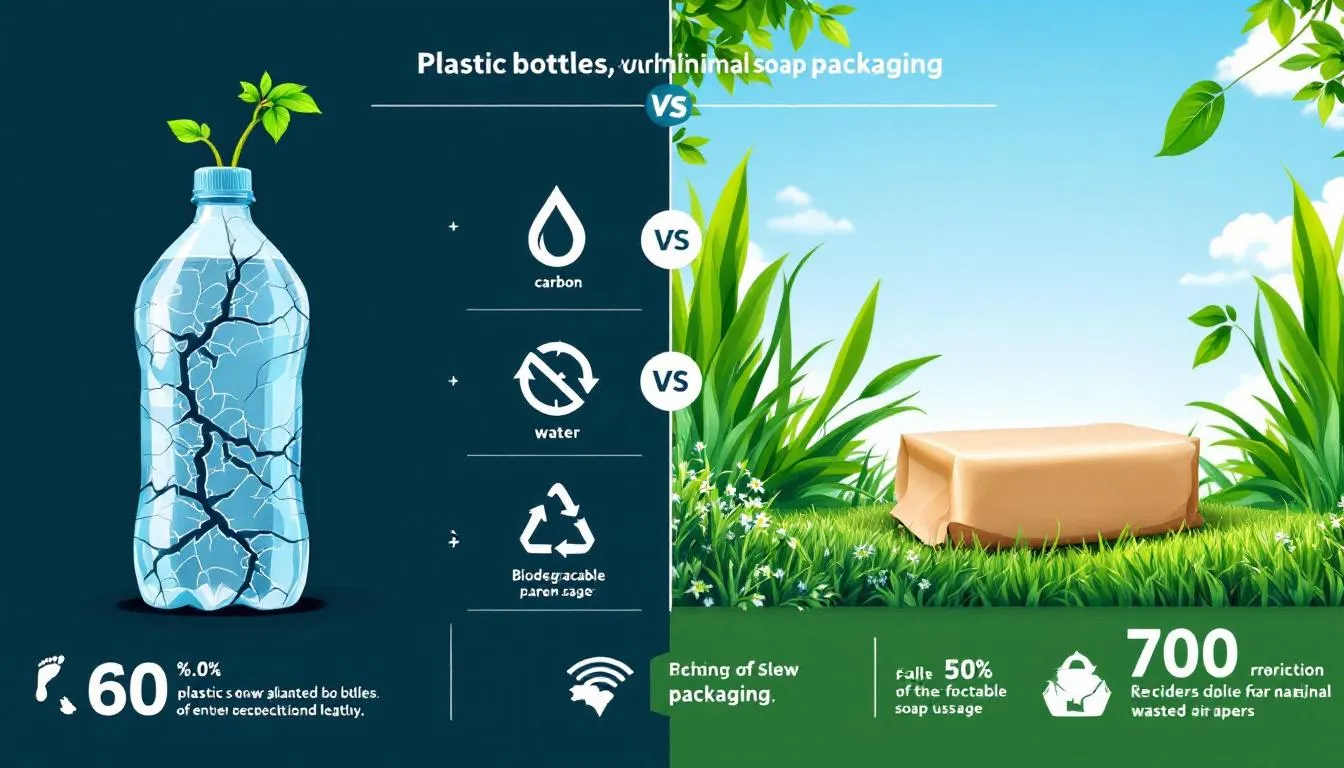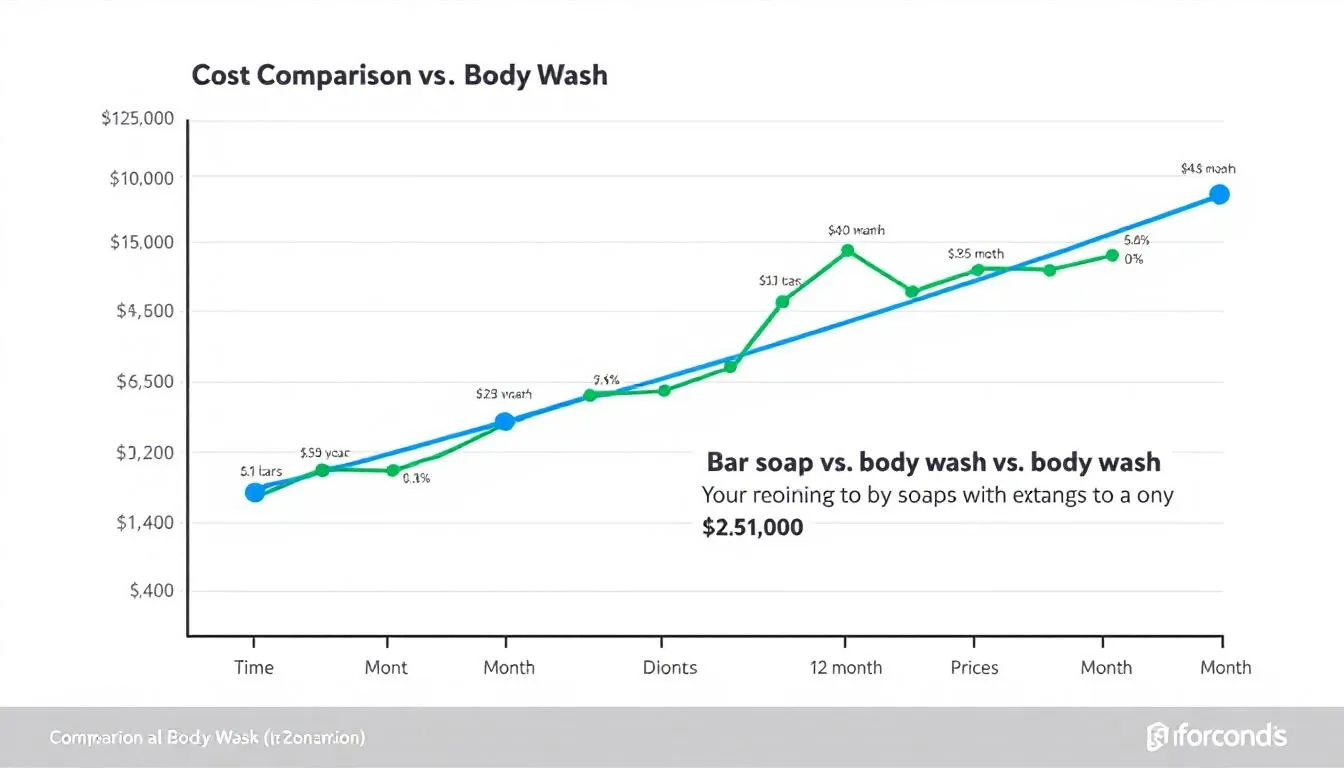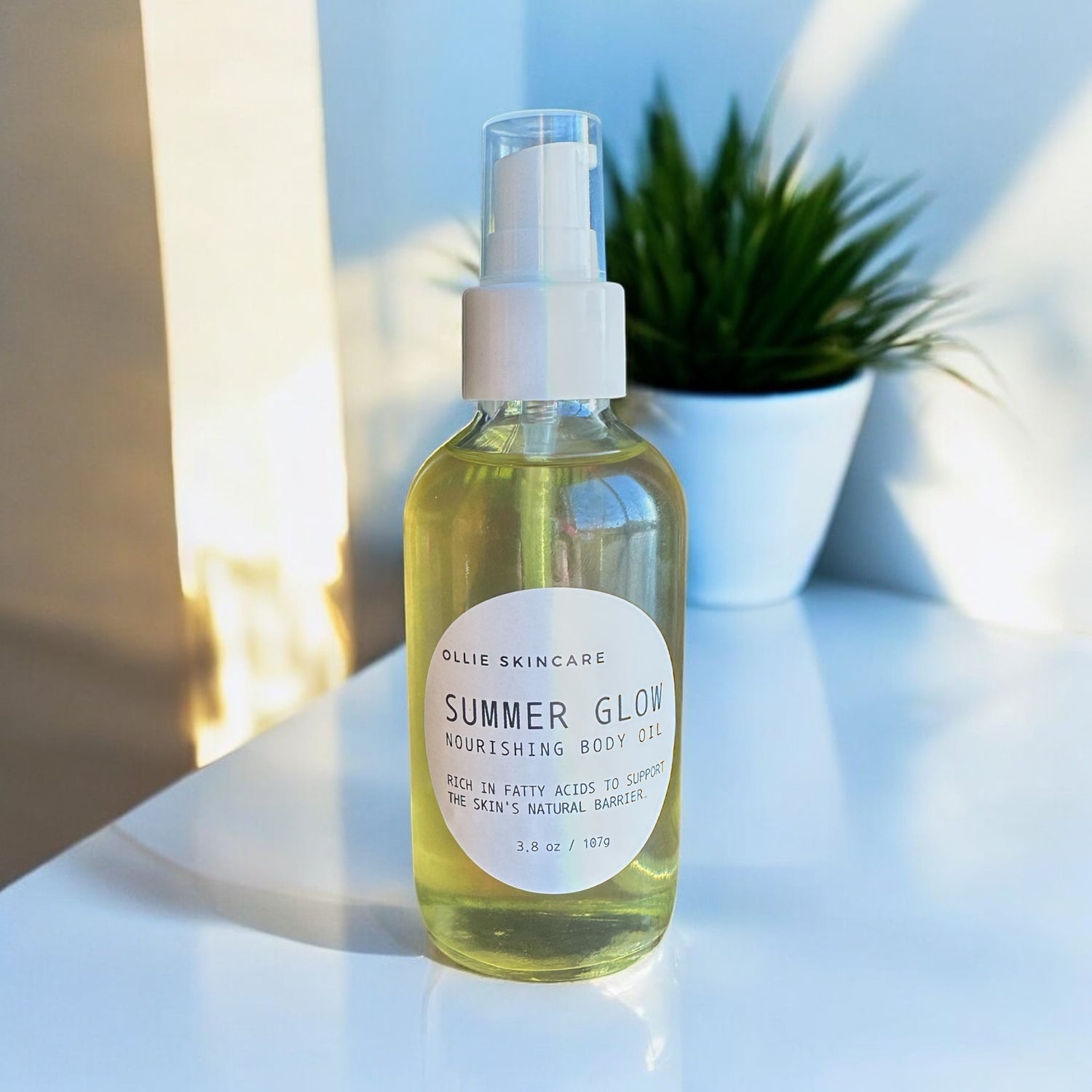Key Takeaways
-
Bar soap is a solid cleanser with a higher pH (9-10) that lasts longer and uses minimal packaging
-
Body wash is a liquid cleanser with a pH closer to the skin’s natural level (5.5) and often contains moisturizing ingredients
-
Bar soap is more economical and eco-friendly, while body wash offers better hydration and specialized formulations
-
Choose bar soap for sensitive skin and travel, body wash for dry skin and targeted skin concerns
-
Both effectively cleanse skin but differ in formulation, cost, and environmental impact
Standing in the personal care aisle, you’re faced with rows of cleansing options that promise everything from deep cleaning to luxurious hydration. The choice between soap and body wash isn’t just about personal preference – it’s a decision that affects your skin health, budget, and environmental impact every day.
Whether you’re dealing with dry or sensitive skin, acne-prone skin, or simply want the most effective way to remove dirt and maintain good personal hygiene, understanding the key differences between these body cleansers can transform your shower routine from ordinary to optimized.
In this comprehensive guide, we’ll break down everything you need to know about bar soap vs body wash, from the chemistry behind how they cleanse your skin to the practical considerations that should guide your choice.
What is the Main Difference Between Body Wash and Soap?
The fundamental difference between body wash and bar soap lies in their manufacturing process and chemical composition. Bar soap is created through saponification – a chemical reaction where oils and fats are heated with sodium hydroxide (lye) and then cured for 6-8 weeks. This traditional process creates true soaps with a characteristic alkaline pH.
Body wash, on the other hand, is a liquid formulation made with water, synthetic detergents, and additional conditioning agents. Unlike traditional soaps, most body washes use surfactants similar to those found in laundry detergent, but formulated specifically for skin contact. Bar soap, by contrast, undergoes a caustic process that involves heating oil and wax, and adding lye, which contributes to its solid form and unique cleansing properties.
The pH level represents the most significant chemical difference between these cleansing agents. Bar soap typically maintains a pH between 9-10, making it more alkaline than your skin’s natural acid mantle. Body wash ranges from 5.5 to 7, which is much closer to your skin’s natural acidity level of 5.4 to 5.9. Additionally, body washes tend to be gentler and less stripping on the skin than bar soaps, making them a preferred choice for those with sensitive or dry skin.

This pH difference affects how each cleanser interacts with your skin barrier. The higher pH of traditional soaps can disrupt your skin’s protective acid mantle, while the gentler pH of body wash helps maintain this crucial protective layer, keeping moisture in and harmful bacteria out. Liquid body washes also tend to be more moisturizing and calming on the skin compared to bar soap, thanks to their inclusion of hydrating ingredients.
Benefits of Bar Soap
Bar soap offers compelling advantages that make it the preferred choice for many skin types and lifestyles. The economic benefits alone are substantial – bar soap costs 50-70% less than body wash and lasts 2-3 times longer per use, making it significantly more cost-effective for families and budget-conscious consumers.
From an environmental perspective, bar soap demonstrates clear superiority. It uses 90% less packaging than liquid body washes and produces 10 times fewer carbon emissions during transport due to its concentrated form and lighter weight. Bar soaps also generally do not contain microplastics or other ecologically problematic ingredients, making them a more environmentally friendly option overall.
The ingredient simplicity of bar soap reduces potential allergen exposure. Quality bar soaps contain fewer ingredients overall, which means fewer chemicals and preservatives that could trigger skin reactions. This makes bar soap particularly suitable for those with sensitive skin who need to minimize their exposure to potential irritants.
For travelers, bar soap offers unmatched convenience. Unlike liquid body washes, solid cleansers are exempt from TSA restrictions or 3-1-1 rule limitations. A single bar can replace multiple liquid products without taking up valuable luggage space or risking spills.
Bar soap also eliminates the need for additional tools, such as loofahs or washcloths, to create lather, although many people prefer using these accessories. The soap effectively cleanses skin by itself, removing dead skin cells and dirt through its natural surfactant properties.
Benefits of Body Wash
Body wash excels in areas where bar soap traditionally falls short, particularly in moisturizing properties and specialized formulations. Modern liquid body washes contain humectants, such as glycerin and hyaluronic acid, that actively retain skin moisture during and after cleansing, leaving the skin feeling hydrated rather than tight or dry.
The specialized formulations available in body wash form address specific skin concerns with targeted active ingredients. You can find formulations with salicylic acid for acne-prone skin, ceramides for skin barrier repair, or alpha-hydroxy acids for gentle exfoliation. These targeted treatments aren’t typically available in bar soap formulations.
Hygiene advantages make body wash particularly appealing in shared living situations. Pump dispensing reduces bacterial contamination compared to shared bar soap, which sits in a soap dish where bacteria can breed. Each use delivers fresh product without the cross-contamination risks associated with communal bar soap use. Additionally, body wash stored in bottles avoids direct contact with water and skin, further enhancing its hygienic appeal.
The gentler cleansing action of body wash preserves your skin’s natural acid mantle through its lower pH formulation. This pH balance helps maintain the skin's barrier function, which protects against environmental irritants and prevents excessive moisture loss.
Body wash also offers superior convenience for those who prefer shower gel consistency and the ability to easily distribute the cleanser across large body areas. The gel-like consistency spreads evenly and rinses clean without leaving residue that some bar soaps can leave behind.
Drawbacks of Each Cleanser Type
Despite their benefits, both bar soap and body wash have notable disadvantages that may influence your choice. Bar soap can leave soap residue on skin and shower surfaces, particularly in areas with hard water, where mineral deposits combine with soap to create that familiar film. The soap dish environment can harbor bacteria if not kept clean and dry, potentially creating hygiene issues in shared bathrooms.
The higher pH of traditional bar soaps can strip natural oils from certain skin types, leading to dryness, irritation, or even disruption of the skin microbiome. This makes some bar soaps unsuitable for people with very dry or sensitive skin conditions.
Body wash drawbacks center primarily on environmental and economic concerns. The plastic packaging generates 25% more plastic waste annually compared to the minimal packaging of bar soap. The preservatives necessary to maintain liquid formulations can cause reactions in sensitive individuals, and synthetic detergents may be harsher than the fatty acids found in traditional soaps. Many body washes also require preservatives to prevent mold growth, which can have additional environmental implications.

Cost represents another significant drawback – body wash typically costs 2-3 times more than bar soap per use, resulting in substantial expense differences over time. The need for additional tools, such as loofahs or washcloths, to generate adequate lather can breed bacteria if not properly maintained and regularly replaced.
Which Cleanser is Best for Your Skin Type?
Your skin type should be the primary factor in determining whether to choose soap or body wash. For sensitive skin, bar soap with fewer ingredients significantly reduces the risk of allergic reactions and contact dermatitis. Look for gentle formulations that are free from harsh fragrances and synthetic additives, which can trigger sensitivity responses. Body wash, on the other hand, is often formulated with gentle, calming, and hydrating ingredients to improve skin feel, making it a better option for those with dry or irritated skin.
Dry skin benefits most from body wash formulations that contain ceramides, shea butter, or natural oils, such as coconut oil. These moisturizing ingredients help combat the moisture loss that occurs during cleansing, leaving skin feeling hydrated rather than tight. The lower pH of body wash also helps preserve the skin barrier that prevents excessive water loss.
Individuals with oily or acne-prone skin should consider using a body wash containing 2% salicylic acid or tea tree oil for targeted treatment benefits. These active ingredients can help reduce excess sebum production and prevent clogged pores while maintaining the skin’s protective barrier.
People with normal skin can successfully use either option – the choice often comes down to personal preferences regarding texture, scent, and lifestyle factors. Consider your daily routine, environmental priorities, and budget when making this decision.
Certain skin types may need to avoid specific formulations entirely. Individuals with eczema or psoriasis should avoid products containing sodium lauryl sulfate and opt for gentle, fragrance-free formulations, regardless of whether they choose bar soap or body wash.
Key Ingredients to Look For
Understanding beneficial ingredients helps you select the most effective body cleanser for your needs. Moisturizing agents, such as glycerin, hyaluronic acid, and ceramides, help maintain skin hydration during the cleansing process. Natural oils, such as argan, jojoba, and coconut oil, provide additional nourishment and help restore the skin's barrier.
Gentle cleansing agents make a significant difference in how your skin responds to daily washing. Look for sodium cocoyl isethionate or coco-glucoside instead of harsh sulfates that can strip protective natural oils. These milder surfactants effectively remove dirt and oil without compromising skin health.
Active ingredients for specific concerns can transform your cleansing routine into a targeted skincare regimen. Salicylic acid helps with acne and clogged pores, lactic acid provides gentle exfoliation to remove dead skin cells, and niacinamide supports skin barrier repair and reduces inflammation.
For those prioritizing natural formulations, seek out plant-based oils, botanical extracts, and minimal synthetic additives. Ingredients such as oatmeal, honey, and aloe vera offer soothing properties while effectively cleansing the skin.
The presence of fatty acids in quality bar soaps or body washes helps maintain skin suppleness and supports the natural protective barrier that keeps moisture in and irritants out.
Ingredients to Avoid in Body Cleansers
Certain ingredients commonly found in body cleansers can cause more harm than good, particularly for those with sensitive or compromised skin. Sodium lauryl sulfate (SLS) represents one of the most problematic ingredients, as it can cause significant dryness and irritation by stripping away natural protective oils.
Synthetic fragrances pose risks for sensitive individuals, potentially triggering allergic reactions and even hormone disruption in some cases. These artificial scents often contain dozens of undisclosed chemical compounds that don’t contribute to cleansing effectiveness.
Parabens and phthalates, common preservatives in many conventional formulas, are potential endocrine disruptors that may interfere with hormonal balance. While the research is still evolving, many consumers prefer to avoid these controversial ingredients as a precautionary measure.
Triclosan, an antibacterial agent found in some cleansers, may disrupt the beneficial bacteria that naturally protect your skin. This disruption of the skin microbiome can actually increase your susceptibility to harmful bacteria and skin infections.
Other chemicals to avoid include formaldehyde-releasing preservatives, artificial colors that serve no cleansing purpose, and alcohol-based ingredients that can dry and irritate skin with regular use.
Cost and Environmental Comparison
The financial impact of your cleanser choice adds up significantly over time. Bar soap costs an average of $0.15-0.25 per use compared to body wash at $0.30-0.50 per use. For a family of four, this difference amounts to hundreds of dollars annually in personal care expenses.
Environmental considerations reveal even starker contrasts between these options. Bar soap uses 95% less plastic packaging than equivalent body wash volumes, directly reducing household plastic waste. The manufacturing process for liquid products requires 5 times more energy than bar soap production, contributing to a larger carbon footprint.
Water usage during manufacturing also favors bar soap, which requires 30% less water to produce than liquid alternatives. When you factor in packaging, shipping weight, and shelf life, bar soap demonstrates clear environmental advantages across multiple metrics.

However, the convenience and specialized formulations of body wash may justify the additional cost for individuals with specific skin concerns or lifestyle needs. The key is understanding these trade-offs and making informed decisions based on your priorities.
How to Choose Between Body Wash and Soap
Making the right choice requires evaluating multiple factors specific to your situation. Start by honestly assessing your skin concerns – dryness, sensitivity, acne, or aging needs all point toward different formulation requirements that may favor one option over the other.
Consider your lifestyle factors carefully. Frequent travelers benefit from bar soap’s portability and lack of liquid restrictions. Families sharing bathrooms might prefer the hygiene advantages of pump-dispensed body wash. Those with limited shower storage may appreciate the minimal space requirements of bar soap. Meanwhile, body wash brands are increasingly focusing on sustainability, often using post-consumer recycled plastic for their packaging to address environmental concerns.
Budget considerations extend beyond initial purchase price to include replacement frequency and long-term costs. Calculate the per-use cost of your preferred products to understand the true financial impact of your choice.
Environmental priorities increasingly influence consumer decisions. If reducing plastic waste and carbon footprint matter to you, bar soap offers clear advantages. If you prioritize specialized skincare benefits, environmentally conscious body wash brands are developing more sustainable packaging options.
Don’t overlook the importance of simply trying different options to discover what works best for your skin and preferences. What matters most is finding a cleanser that leaves your skin feeling clean, comfortable, and healthy after each use.
FAQ
Can you use body wash as a substitute for shampoo?
Using body wash as shampoo isn’t recommended for regular hair care. Body wash typically has a pH of 5.5-7, while shampoos are formulated with a slightly lower pH (4.5-6) to properly cleanse the scalp and hair cuticles. Additionally, shampoos contain specific detergents designed to remove oil buildup and product residue from hair, whereas body wash focuses on gentle cleansing of the skin. Regular use of body wash on hair can lead to buildup, inadequate cleansing, and potential scalp irritation.
How long does bar soap last compared to body wash?
A standard 4-ounce bar of soap typically lasts 4-6 weeks with daily use, whereas an equivalent volume of body wash lasts only 2-3 weeks due to its liquid consistency and tendency to be overused. Bar soap’s concentrated form means you use less product per application – usually just the amount needed to create adequate lather on wet skin. Body wash users often dispense more product than necessary, particularly when using pump bottles or squeeze containers.
Is antibacterial soap necessary for daily use?
Regular antibacterial soap isn’t necessary for most people’s daily hygiene routine and may actually be counterproductive. Plain soap and hot water effectively remove harmful bacteria and viruses through mechanical action rather than chemical killing. Overuse of antibacterial agents can disrupt your skin’s natural microbiome – the beneficial bacteria that help protect against harmful pathogens. The FDA has actually banned many antibacterial ingredients like triclosan from consumer soaps due to a lack of proven benefits and potential health risks.
Can bar soap clog shower drains?
Bar soap can contribute to drain clogs, particularly in areas with hard water, where soap combines with mineral deposits to form a scum-like substance known as soap scum. This residue can accumulate in pipes over time, especially when combined with hair and other debris. To minimize this risk, use a drain strainer to catch hair and debris, rinse thoroughly after use, and periodically flush drains with hot water. Modern liquid body washes are less likely to cause this issue due to their different chemical composition.
Do dermatologists prefer body wash or bar soap?
Dermatologists don’t universally prefer one over the other – their recommendations depend on individual skin conditions and needs. For patients with eczema, psoriasis, or very dry skin, many dermatologists recommend gentle, moisturizing body washes with ceramides or other barrier-repair ingredients. For those with sensitive skin or allergies, they might suggest simple, fragrance-free bar soaps with fewer potential irritants. The key factor is choosing products that are appropriate for your specific skin type and any underlying conditions, regardless of the format.





